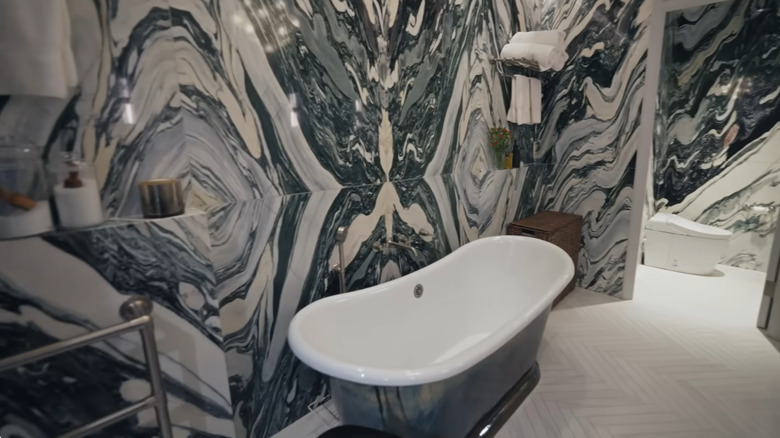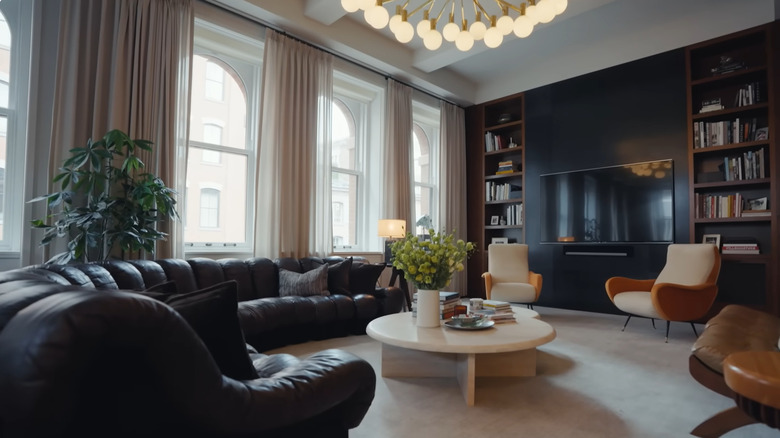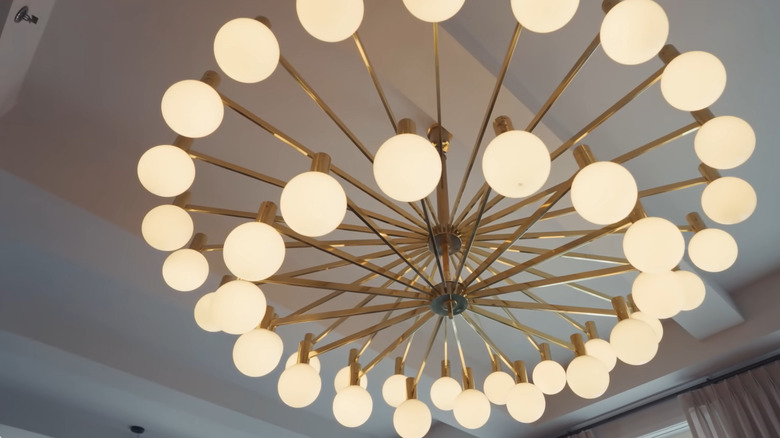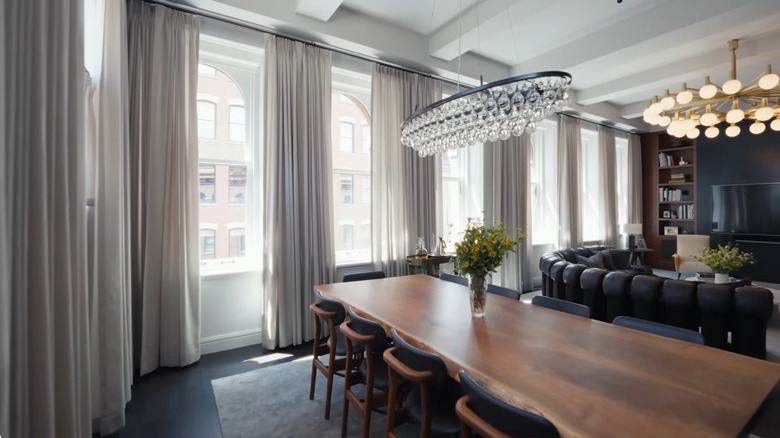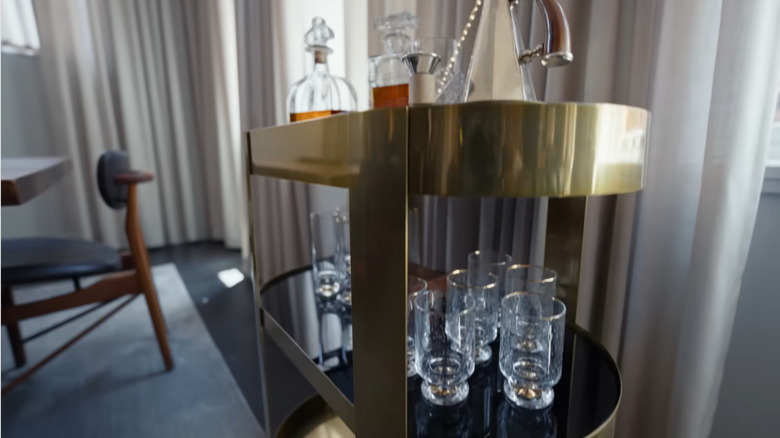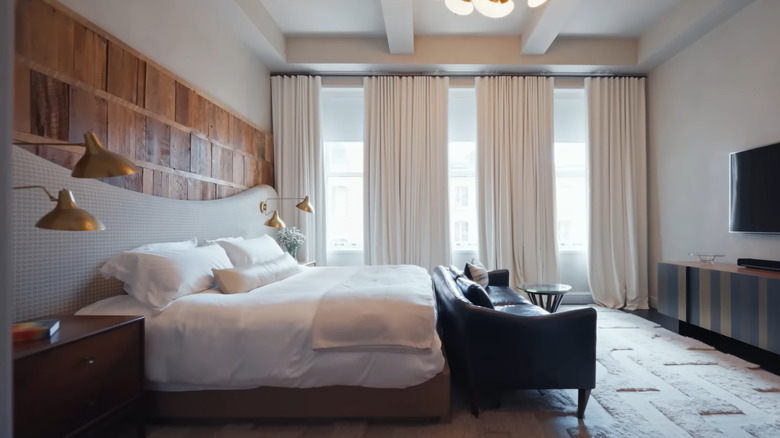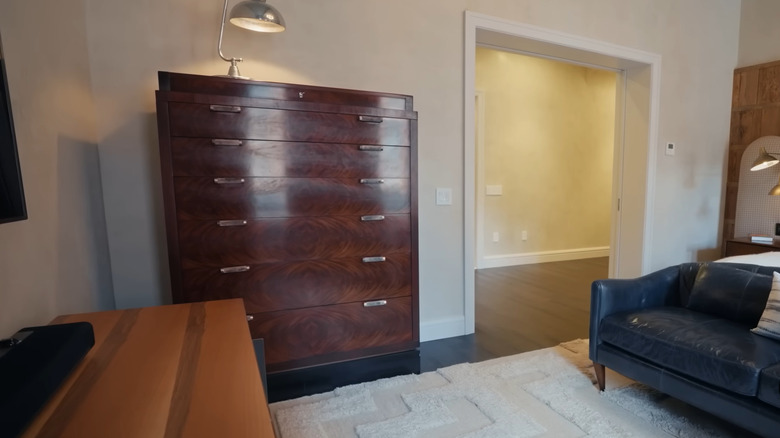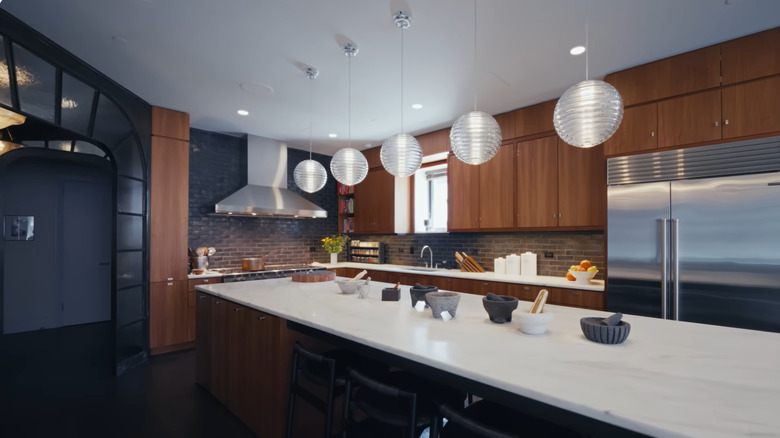Take A Tour Inside Bobby Flay's Refined NYC Apartment
A decade after chef Bobby Flay fell hard for the historic feel and 14-foot ceilings in his 3,800-square-foot loft in New York City's Tribeca neighborhood, he was ready for a new recipe. "I really liked my apartment," he explained in a profile with Architectural Digest. "But I really wanted to love my apartment." Though he briefly considered a move away from the Beaux-Arts landmarked building, he felt the downtown area he called home had a special "old New York" feel to it. He just needed to change up a few key ingredients in his space.
His sous chef for the project was Olivia Capuano. Having helped whip up some magical spaces — including his Las Vegas eatery Amalfi and the set for "Bobby's Triple Threat," one of Flay's many eponymous Food Network shows — the renowned chef knew that the Olivia Jane Design founder would create magic. And after a six-month renovation, she served up an eye-catching space featuring vintage pieces from their marathon 1stDibs shopping sessions, statement-making marble, and stand-out lighting fixtures. And since his cook space had already been outfitted with an extended kitchen island and a professional-style BlueStar range before he moved in, noted Flay, "The ironic part is we basically left the kitchen alone."
The entryway is reminiscent of one of his famed eateries
Guests to Flay's loft leapt from the frying pan straight into the fire, so to speak. "You open the door to Bobby's apartment and you're in the kitchen — of course; makes sense," he mused to the outlet. But he was bothered by the abruptness, desiring a moment to pause before diving into his work space. And so Capuano came up with a trés chic solution after a day of touring Parisian apartments, sketching out a vignette of antique brass and cast glass arched doorways during a dinner meeting. "It really is like a little jewel box," Flay explained to Architectural Digest (via YouTube). "You have, like, distressed mirrors, you have the stained glass that you can kind of see through, but not quite."
To best decorate your entryway, consider adding in architectural elements such as paneling, picture frame molding, or even create a wainscoting effect with wood. You can also go bold with a statement wall, using wood, brick, or an eye-catching wallpaper. Other entryway design trends that allow visitors to take a beat before stepping into your space include adding a piece of framed art or an ornate mirror, incorporating greenery, and hanging a chandelier that draws eyes up.
The bathrooms feature five different types of marble
When initially designing his space 10 years earlier, Flay opted for a subtle stone when choosing kitchen countertops. But when he and Capuano paid a visit to New York City's ABC Stone to pick materials for his five bathrooms, he was ready to, uh, rock, opting for bold, dramatic veining. "He was like, 'If we're doing it, we're doing. I want to see it,'" explained Capuano. And it's hard to miss the bold black and white Fantastico Arni marble that covers nearly every inch of one bath. The very opposite of minimalistic, said Flay, "This is the room Olivia says it's like taking a shower in an oil painting."
But if marble feels like too high-maintenance of an option for your space — while beautiful, the natural stone is soft and highly porous, meaning it can crack and stain more easily — consider countertops that mimic the beauty of marble. Ceramic slabs offer the same aesthetic at a lower price, while man-made quartz is more durable and less porous. Corian is another budget-friendly pick that tends to withstand some wear and tear, and concrete is heat- and scratch-resistant. And, while on the pricier side, Dekton is a nice blend of quartz and porcelain, offering an attractive look that is virtually non-destructible.
A uniquely shaped sofa is ideal for entertaining in the living room
A consummate host, it was crucial to Flay that his living room felt open to the kitchen so he could both tend to the food and mix it up with his dinner party guests. So, the lover of vintage pieces — "Especially things from, like, the '60s and '70s" — wanted to be sure his entertaining space had all the right flavors. The strongest was the vintage De Sede DS600 Non Stop Sectional in a chocolate brown leather he found at a store in Jersey City. "It has this very recognizable style," Flay explained. "It's like individual pieces put together, almost like a snake. You can actually reshape this in lots of different ways." Arranged in a semi-circle ensured it's open both to his kitchen and the collection of other seating, like a Marco Comolli sofa and two-toned velvet armchairs. Said Flay, "They all kind of work together."
To choose the right sofa shape for your living room, you'll want to consider the size of your space (a smaller room calls for more streamlined seating) and how you plan to walk through the area. The right sofa won't impede any natural pathways or force you to awkwardly navigate around. As a test, block out the shape of any sectional or loveseat you've been considering using painters tape and live with it for a day or two. That will give you a front row seat to how it will work in your home.
The apartment's lighting sets the tone for the rest of the space
In Flay's loft, light fixtures are a true bright spot. While furniture tends to garner the most notice, "lighting to me is really, really important," explained Flay, "and I love finding vintage lights." To him, he added, "the lighting in the living room, the lighting in the dining room, the lighting in the kitchen, it sets the tone for the design of the house." With the dining space's eye-catching Ochre fixture, for instance, "Each one of these individual glass drops kind of reflects the light coming from the bulbs in this really cool way," he detailed. But it's an oversized chandelier shipped from the Netherlands that truly makes the whole place shimmer. As Flay shared, "After Olivia showed me what she wanted the living room to feel like. I said to her, 'I'm gonna find a light that I think can tie this whole thing together.'"
Choosing the right light fixture to boost your living room means more than just finding a piece you take a shine to. Having a good mix of options on hand — table lamps, sconces, and tape lighting, in addition to any overhead bulbs — allows you to customize the vibe at any given time. And you'll want each fixture to coordinate with the size of the space. Which means if you have your heart set on a grand overhead chandelier for a living room with low ceilings, you'll want to pick something that brings the drama, not necessarily the size.
A tiny change to the dining table made a huge difference in the dining room
Eager to open up his main living space, Flay listened when Capuano pitched the smallest of tweaks. Rotating his Ochre light fixture meant they could shift the direction of the dining table situated underneath to run parallel to the wall, which freed up much needed square footage in the living room. "To me, this has been the biggest change in the renovation of this apartment, and this is where Olivia really did some of her best work," said Flay. "All we did was we changed the direction of the dining table. The idea was to make this room much more inclusive. Now everybody gravitates here."
An open concept is a highly desired element in a home, but if you're struggling to make yours feel cohesive, consider this solution for breaking up your open floor plan. Using furniture and other larger pieces like area rugs and taller plants, you can create zones in a bigger space. You'll want one standout item (think: a window, fireplace, or media console) to anchor the area and then can strategically arrange furniture to give that spot an enclosed feeling. For instance, a set of bookshelves placed around a desk can create an office, while a shelving unit with hooks and baskets can delineate a foyer from the living room.
The one part of the living room that Flay considers a nod to James Bond
With his living room already quite the destination place for friends, it was crucial for Flay to have one spot to, well, shake things up a bit. "I think a bar cart is important," noted Flay of his entertaining must-have. "There's something, I don't know, James Bond about it." A bourbon drinker, he added, "I like to pour myself a little sip and call it a night."
But if a bar cart isn't your thing, there are plenty of other ways to cause a stir. Consider swapping out the more traditional cart for a cabinet that elevates your serving station. Already featuring finery like detailed carvings or mirrored shelving, an elegant china cabinet affords more space to display your favorite apéritifs, glassware, bar tools, and other decor. Plus, since it's an enclosed space, it'll be easier to keep your tumblers and high ball glasses dust-free. Chic, very chic.
The den strikes a moody tone
A bedroom by any other name is just another place to Netflix and chill. "This was meant to be a bedroom when I first moved in, but I really didn't need one extra bedroom," Flay explained of the area he transformed into a secondary hangout spot, calling it a space that's "a little more cozy than my living room." He created the hygge vibes using slate-hued Phillip Jeffries glasscloth wall coverings, a blue Art Deco-inspired Nordic Knots rug, a sculptural Roll & Hill Modo chandelier, and a caramel-colored leather sofa perfect for sinking into during the winter. Said Flay, "In the colder months, I spent a lot of time in the den."
While it's tempting to choose a seating space solely with comfort in mind, you may also want to consider some of the year's biggest couch trends. In recent months, sleek minimalist picks have been eclipsed by more attention-grabbing seating. The boomerang-shaped sofa is a retro design that swaps straight lines and corners for a curved silhouette. Meanwhile, '70s-era modular couches have fallen into favor because you can use the various pieces to customize your configuration.
Playing with textures turned the bedroom into a cozy haven
The right bedroom space will give you all the feels, so Capuano brought a bunch of textures to the party in Flay's main bedroom. With a reclaimed wood feature wall already in place, the designer added Venetian plaster to the other walls and ceiling, selected a high-pile Nordic Knots boho-style rug, and covered a curved custom headboard in Dedar Chérie jacquard. The goal, she described, was to create "a really warm envelope of space and color." It's those touches — plus a midnight blue Arteriors Vincent sofa he sits on to watch the morning news — that has Flay raving that "it's built for comfort."
For those looking to layer on different types of surfaces, there are a few ways to add texture to your home decor. Fabrics and furnishings are a good place to start (say, a knotted jute area rug and a plush wool rug). Leaning into natural materials also adds visual interest, perhaps a stacked wood feature wall and a stone fireplace. And don't forget to plant some roots with lush, leafy greens and other types of flora.
His space is filled with timeless furnishings that never go out of style
Much like his signature shrimp and roasted garlic tamale, Flay favors furniture that truly stands the test of time. One of his longest standing relationships is with the Ralph Lauren dresser in his bedroom. "I think I've had this for 25 years," Flay said of the six-drawer chestnut brown piece. "This is the kind of furniture that I like to buy. It never goes out of style. This thing is classic. It's gorgeous, obviously functional." Another favorite is a multi-toned credenza from Italy, noted Flay: "Each one of these is sort of a different metal, kind of like layered on top of each other. And I just love it."
Flay is a fan of scouring online marketplace 1stDibs for vintage pieces. "We open a bottle of wine," he said of his process with Capuano, "and we sit there for three hours and we just start bidding." And there are plenty of vintage brands that are always worth buying when you spy them. Focused on solid wood pieces before the 1990s, Ethan Allen items tend to be sturdy, while glassware from Brooklyn brand Culver Canella can be quite valuable. And an authentic Herman Miller — like the famed Eames lounger or Isamu Noguchi's glass-topped coffee table — is a perpetually smart buy.
Flay's kitchen is equal parts pretty and practical
Being used to cooking in industrial, cramped kitchens, "It's nice to come home to some breath," Flay raved of his kitchen, designed with having space to prep and entertain in mind. Before moving in 10 years ago, he extended the length of the kitchen island. "It was really important for me to have lots of sort of landing area," he explained. "That's one of the things that I think that people underestimate when they're building kitchens. You need places to put things and work on." Other crucial pieces include his Blue Star range that's "as close to a professional stove that you can have," he said. "It has a lot of firepower." Also key is his wipe-clean backsplash. Said Flay, "You want a material that you can wash easily, but also you want something that looks cool."
And if individual tiles aren't your thing, you can try one sleek alternative that's more unique: glass panels. While glass panels will require a bigger investment upfront — and should be installed by a professional — it's easy to see the upsides. Not only can they be customized using various colors or even a wallpaper behind the clear panels, since glass is non-porous, it's resistant to stains and germs. Easy to wipe clean, the reflection can also make smaller kitchens appear more spacious.
Yes, he stores a lot of pots and pans (cookbooks too!)
On the menu in Flay's kitchen? Plenty of storage. His Henrybuilt space comes equipped with plenty of room for his collection of molcajetes (including one he recently picked up from a Mexico City boutique), knives, and cookware. "In terms of, like, my restaurant influence to my home," said Flay while displaying an entire pantry for pots and pans, "I have things like this, where it's like, these little individual cast iron pans." He also has shelving in his kitchen for just a small portion of his culinary tomes. Joked Flay, "I have cookbooks everywhere."
With storage actually serving as the kitchen feature buyers look for most that can boost your home's value, it's smart to squeeze it in wherever possible. For those looking to renovate, consider installing cabinetry up to the ceiling to add in a few more crucial inches, or adding pullout racks and drawers for spices and sheet pans. Or try a few creative DIY pantry ideas like installing a center cabinet between your upper and lower set or making the most of a slim corner with a narrow bookshelf on wheels.
Of course, the dining room is styled with large dinner parties in mind
Naturally, the three-time James Beard Foundation Award winner likes to serve up some fun for his guests. So, his spacious table was another original purchase that was chosen to suit his family-style dinner parties. "I bought this table when I moved into this apartment over 10 years ago," Flay said of the farmhouse-style piece. "I love kind of the smooth edges of it, but it's not like perfectly cut. So, I kind of like that rustic feel to it. I just think it's just so beautiful. You can see all the grain from the wood." The chairs, also scooped up before he moved in, were recently reupholstered in Tiger Leather's Empire Havana. "I love the design," Flay raved. "I think they're gorgeous."
As crucial as it is to pick a material you'll salivate over, the dining room design mistake that is all too easy to make is fill it with too many furnishings. It creates a too-many-cooks-in-the-kitchen situation that can make the room feel too crowded and stuffy. House Digest design historian Sarah Bilotta suggests avoiding "large, imposing pieces of furniture, traditional turned wood chairs and tables, and heavy, dominating cabinetry (like china cabinets)." Instead, make the space more flexible by employing a table on casters, extra seating like a bench that can be tucked out of view, and a bar cart that can be rolled in when needed.


